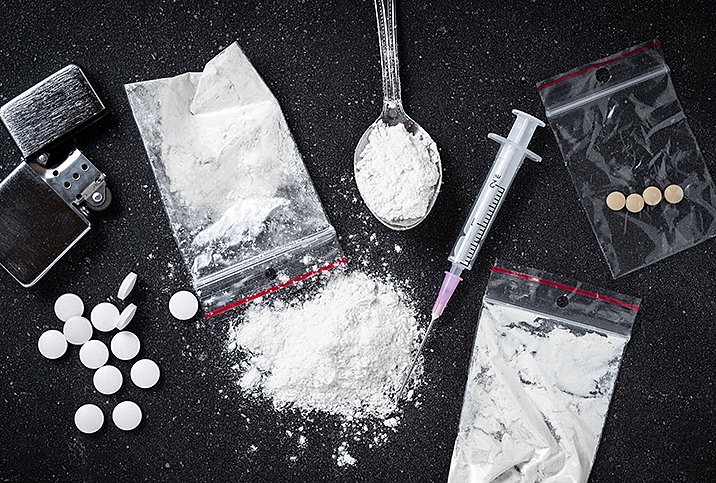How Substance Use Disorder Is Diagnosed

If you're concerned that you or a loved one may be suffering from a substance use disorder (SUD), getting evaluated is an essential first step to recovery.
Here's how it works.
Understanding SUD
Substance use disorder is the clinical term for the inability of a person to control the use of a drug or medication. Addiction can occur with a wide array of substances—alcohol, nicotine, illegal drugs such as cocaine or prescribed narcotics such as oxycodone.
Addiction can happen to anyone at any age, but it is a greater risk for individuals with a mental health disorder, a history of early drug use, facing peer pressure, or other environmental and genetic risk factors. In 2017, 14.8 percent of Americans ages 18 to 25 had a substance addiction. In most cases, addiction begins with experimental or occasional use of a substance, which then leads to abuse.
Addiction looks different depending on the individual and the drug—one person may become dependent on heroin after a single use, whereas another may drink socially for years before becoming an alcoholic. Addiction to extremely dangerous drugs like methamphetamine often begins with the use of prescription medications and recreational drugs. Opioids, including prescription painkillers, have a particularly high addiction risk.
Signs, symptoms and evaluation
There are multiple signs of drug use: neglected appearance, health and financial problems, disinterest in/neglect of work or school, altered behavior, drastic changes in relationships, defensiveness about substance use and a requirement for greater amounts of the drug to achieve the same effect as increased use leads to increased tolerance.
An important sign that drug use may have reached the point of addiction is when withdrawal begins to occur if the drugs are not administered.
SUDs cause significant damage to the lives of those who suffer from it, as well as their loved ones. In 2019, there were more than 70,600 drug overdose deaths in the United States, with opioids the number-one cause. In addition to overdose, addicted individuals face a variety of dangerous side effects of long-term drug use, including organ damage, dental and eye problems, and neurological and mental health side effects.
An addiction treatment program offering a combination of therapies is the best way to stop using and stay clean. And so, the first step in recovery is getting, and accepting, a diagnosis of SUD.
What to expect
Evaluation of a possible substance addiction begins with a session with a qualified healthcare provider. Drug testing is typically not part of the diagnosis process, although it can play a role in treatment. Rather, the screening focuses on the individual's relationship with the drug, including how, when, where and why they are using, feelings about use and how use impacts their life.
Diagnostic criteria
A diagnosis of substance use disorder will be made by a qualified psychiatrist, psychologist or drug or alcohol counselor, based on the Diagnostic and Statistical Manual of Mental Disorders (DSM-5), which recognizes SUD for 10 different drug classes.
Criteria for diagnosis include:
- Suffering from cravings
- Wanting to cut down but being unable to
- Taking the substance in larger amounts or over longer periods of time than intended
- Spending significant time getting and using the drug
- Failing to complete or giving up other obligations due to use
- Continuing using despite resultant life problems
- Becoming tolerant (needing more of the substance over time)
- Continuing use despite knowing it's a problem
- Experiencing withdrawal symptoms when trying to stop using
Two or three criteria met may be diagnosed as a mild substance use disorder. If six or more of the criteria are met, the diagnosis is serious.
Next steps
If a diagnosis of SUD is made, the patient will be referred for treatment. These referrals will vary based on the severity of the addiction, the substance in question and patient preferences and finances. Options (such as outpatient, residential and inpatient; individual, group or family sessions) typically include a combination of behavior therapy, self-help groups and sometimes medications.
The goal of treatment is not to punish, shame or even cure, as there is no cure for substance use disorder. Instead, treatment is designed to empower each individual to overcome addiction and be able to live drug-free, and without the damaging effects on health and life. Treatment is often a long and winding, imperfect road, and that's okay. Support groups, such as Narcotics Anonymous and Alcoholics Anonymous, and organizations, such as SAMHSA and ASAM, are excellent resources, offering an essential boost during a challenging time.
SUD isn't an easy obstacle to overcome, and most who have faced addiction will say it's a constant and daily battle. But it's a battle worth fighting, and it all starts with putting a name to addiction through diagnosis.

















